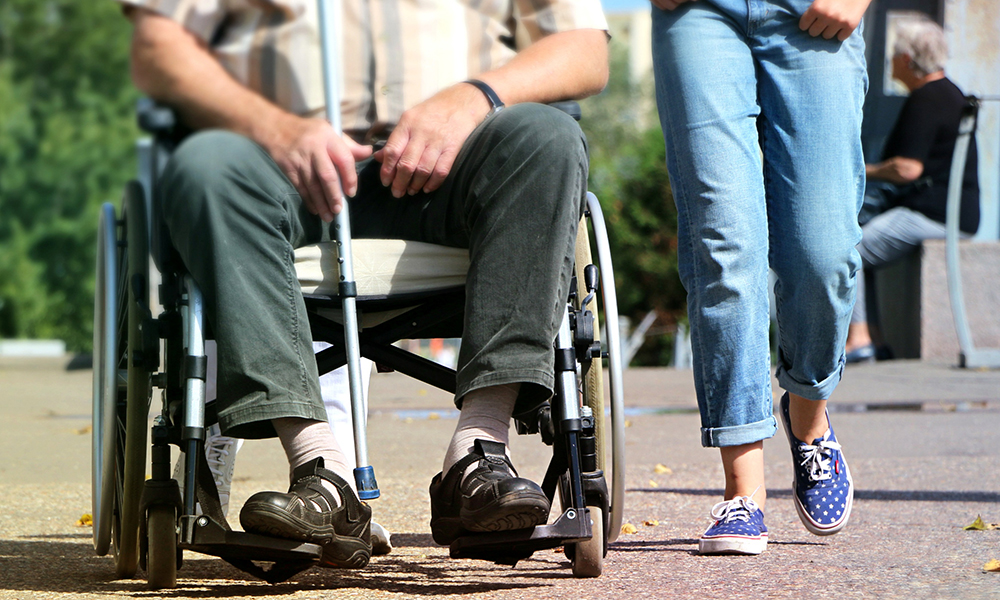by Elise Wachspress
Peripheral artery disease (PAD), the narrowing of the blood vessels in the body outside the heart and brain, affects more than 2 million adults in the United States.
PAD occurs when plaque—an amalgam of fat, cholesterol, calcium, and other substances—builds up on the walls of the arteries to the arms and legs. These corroded “pipes” can restrict or even stop blood flow, particularly in the legs and feet.
The person with PAD may feel no symptoms, but many begin to notice that walking or climbing stairs causes leg pain or numbness which stops on resting. The skin on their feet and legs may look pale, blue, or shiny, and nail and hair growth often slows or stops completely—all indications that oxygen and nourishment are not getting where they need to go.
Over time, people with PAD have increasing difficulty with walking; they are more likely to lose their independence, with major impact on quality of life. Those with very advanced disease may develop sores on the feet and legs, which often heal slowly, or not at all. They are also at risk for problems in the arteries in the heart (coronary artery disease) and in the brain (cerebrovascular disease). Because of the strong connection between plaque in the legs and other parts of the body, PAD is one of the largest risk factors for both heart attack and stroke.
While the disease can start as early as age 40, incidence increases significantly with age. By age 70, more than ten percent of men and nearly as many women are dealing with PAD. For African Americans, the numbers are nearly twice as high.
Clinicians know that smoking, high blood pressure, high cholesterol, and diabetes can set up PAD, but not everyone with these risk factors develop the disease. Physician-scientists are beginning to understand that inflammation—the body’s complex immune response developed to protect against microbial pathogens or other irritants—is also a major player, causing plaque to develop inside the artery walls. But how to pinpoint the irritants that invoke this response? There are millions of kinds of microbes in, on, and around us that could be causing this immune response, but the vast majority—especially those in our gut—are essential for keeping us healthy.
University of Chicago scientists engaged in the fight against PAD are now focusing on the complex interplay of the immune system, inflammation, and the microbiome. Better understanding of the mechanisms involved may yield new tools and strategies against the disease and the heart attacks and strokes that can follow.
The researchers are coming at this problem from three angles: in the lab, in the clinic, and in the broader population.
- In the lab, they are feeding mice high-cholesterol diets to see how the microbial balance in each mouse affects the development of plaque in the arteries. By then transplanting fecal matter from healthy humans into mice with PAD, the team can see if changing the bacterial balance in these mice slows or stops disease progression.
- In the clinic, the team is tracking patients with serious PAD, those with wounds so severe they must have surgery to improve blood flow in hopes of preventing amputations. The team will track how the balance of bacteria, both in the patients’ gut and on their skin, affects blood flow to damaged tissues. By pairing extensive clinical data about these patients—including measures of inflammation in the blood and studies of genetic information —with information on the microbial populations present in each patient, the team aims to identify the balance of bacteria that promotes healing.
- In the wider population, the investigators aim to track 100 patients with PAD over two years. In this much broader group, they hope to discover the connections among each patient’s microbiome, immunological markers, imaging tests that measure arterial health, and, importantly, functional status—through a walking test—to gauge how the microbiome affects not only disease progress but also quality of life. The investigators will also track the participants’ diet and physical activity, two factors well known to influence the microbiome and PAD. Because UChicago Medicine has developed relationships with patients of such diverse ethnic, racial, and economic backgrounds, this study can yield findings to suggest new treatment strategies for a wide spectrum of individuals.
Each of these three studies will inform the others. This three-pronged approach is a classic example of how academic research drives better medicine: 1) find ways to get at the underlying biological mechanisms of health and disease; 2) translate that understanding to address the critical problems of the sickest patients, and 3) develop the knowledge that can help the broader population achieve wellness and the most satisfying life possible.
Elise Wachspress is a senior communications strategist for the University of Chicago Medicine & Biological Sciences Development office




